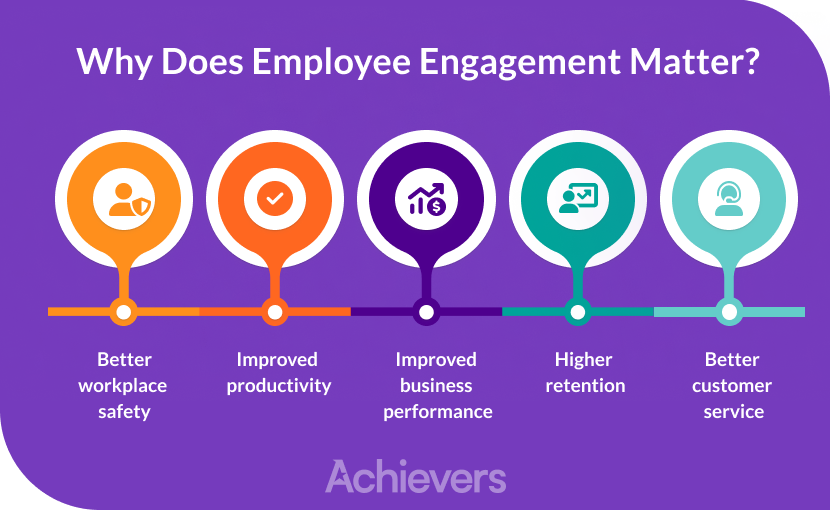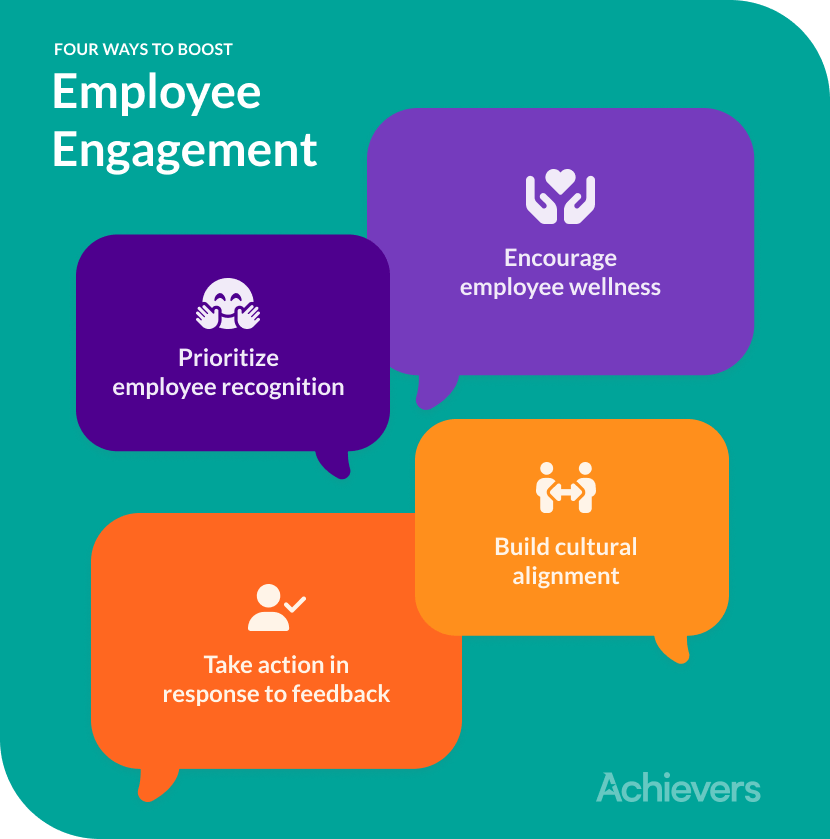Table of contents
Having an employee engagement guide is more than just handy, it’s a tool to help you reduce disengagement — a chronic issue in today’s workplace.
According to the Achievers Workforce Institute’s 2024 Engagement and Retention report, two-thirds of employees have one foot out the door. This sign of low engagement is a serious threat to your bottom line. Low employee engagement cost U.S. companies up to $550 billion a year in lost productivity. On the flip side, Gallup found that highly engaged teams show 23% greater profitability. With so much at stake, it’s no surprise that successful companies put employee engagement at the center of their corporate strategy.
This employee engagement guide has everything you need to make employee engagement a pillar of your organization’s culture, from understanding just what it is to measuring and boosting it. Let’s dive in!
What is the definition of employee engagement?
The definition of employee engagement is a state of a person’s commitment to their work and company. It is a mental and emotional connection that fluctuates and affects everything from retention and organizational performance to your company’s bottom line. Engagement is driven by a wide range of factors, including how frequently employees are recognized and empowered to succeed, and whether organizations solicit and act on employee feedback. To keep track of employee engagement, organizations should use modern tools like pulse surveys and intelligent HR chatbots to establish open, anonymous lines of communication where employees can share honest feedback on these drivers.

Why does employee engagement matter?
When employees are aligned with your company’s vision and form bonds with one another, they’re much more likely to be engaged. Employee engagement is a key driver of success in the modern workforce, including:
- Productivity: Organizations with engaged employees outperform their counterparts by 202%
- Retention: Highly engaged workers are 22% more likely to say that they will not job hunt
- Workplace safety: Organizations that rank in the top quarter for engagement had 70% fewer safety incidents
- Better customer service: Research shows that employee engagement is strongly associated with increased customer satisfaction, as do customer stories like that of Discover, which found that sales increased in lockstep with employee engagement.
- Business performance: Highly engaged business units are 21% more profitable. Conversely, disengagement costs the U.S. economy up to $550 billion per year.
Employee engagement statistics
To understand the holistic impact of employee engagement on an organization and its people, you need only look at the statistics:
- Organizations with highly-rated cultures of recognition are 2.5 times more likely to see improved employee engagement.
- 64% of HR leaders say an always-on feedback tool is essential to an engagement listening program, but only 20% have this kind of tool in place.
- 58% of employees wish their company conducted employee engagement surveys more frequently.
- 71% of executives say that employee engagement is an important contributor to organizational success.
- Alignment with company culture is one of the five key factors that lead to employees feeling satisfied and adequately rewarded.
- Managers are responsible for 10 out of 12 actions to engage employees.
12 ways to improve employee engagement
Boosting employee engagement is essential for productivity, retention, and overall workplace satisfaction. Here are 12 effective strategies to enhance engagement in your organization:
- Recognition: Frequent, specific recognition doubles employee engagement and productivity.
- Feedback: Encourage honest feedback and act on it to show employees their voices matter.
- Culture: Foster a culture where employees feel they fit in, improving collaboration and retention.
- Team: Support a cooperative environment where engaged teammates inspire one another.
- Empowerment: Provide resources and tools so employees feel supported and work efficiently.
- Development: Offer opportunities for skill growth to show investment in employee success.
- Work-life balance: Prevent burnout with adequate PTO, flexible work options, and clear boundaries.
- Expectations: Set clear, realistic job expectations and adjust based on employee feedback.
- Purpose: Strengthen company values to help employees find meaning in their work.
- Role: Ensure employees are well-suited to their roles for better performance and engagement.
- Manager support: Promote coaching-style management to improve communication and motivation.
- Leadership and strategy: Build trust with transparent leadership and sound decision-making.
How do you measure employee engagement?
Measuring employee engagement is the first step toward improving it, but relying on slow, annual surveys delays action and risks further disengagement. Instead, use real-time tools like comprehensive employee engagement software that includes pulse surveys and AI-powered HR chatbots. Pulse surveys are quick, frequent check-ins that gauge key engagement drivers such as job satisfaction, communication, and work environment.
To measure effectively, ensure a high response rate (above 10%), analyze both scaled responses and open-ended comments, and review findings with leadership to align with organizational goals. The most effective pulse surveys use a Likert scale for easy responses with questions like: How do you feel about work today? and What practices do we need to change?
Meanwhile, HR chatbots enhance engagement measurement by prompting survey participation and gathering ongoing anonymous feedback, allowing organizations to track trends related to leadership changes, recognition efforts, and more.

4 ways to boost employee engagement
Tracking employee engagement is a great first step, but turning insights into action is what truly drives lasting results. To keep engagement levels high across your organization, implement these four proven strategies.
- Take action in response to feedback: Use engagement data to create action plans, guiding managers from insight to team-driven solutions.
- Prioritize employee recognition: Follow the RISE principles—recognize regularly, immediately, specifically, and encourage peer recognition—to boost engagement.
- Encourage employee wellness: Offer wellness programs, flexible hours, and recognition for wellness goals to reduce burnout and improve productivity.
- Build cultural alignment: Define, implement, and track cultural values to ensure alignment from hiring to leadership, driving stronger engagement.
Choosing the right employee engagement software
Engaged employees make a good organization great. They bring energy, positivity, and productivity to your company. But engagement is an ever-changing metric that employers need to monitor on a regular basis. To keep employees engaged, you need a tool that can help you launch pulse surveys, consistently solicit feedback, and turn that input into action. While 64% of HR leaders agree that an always-on feedback tool is essential to an engagement program, only 20% have one in place.



